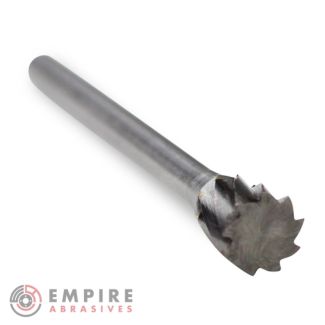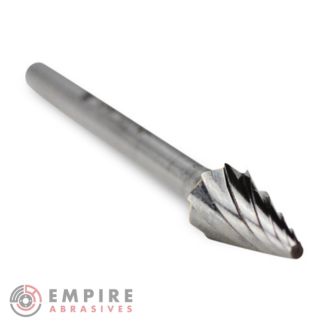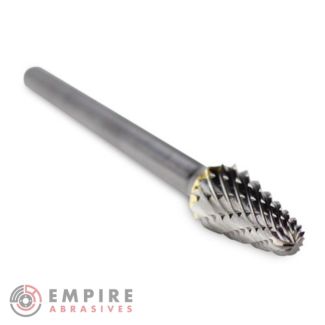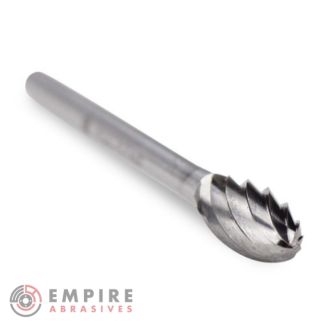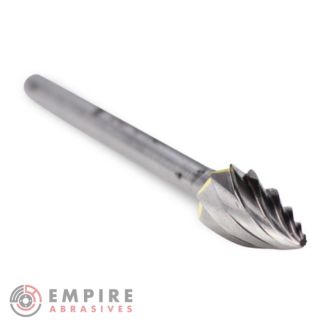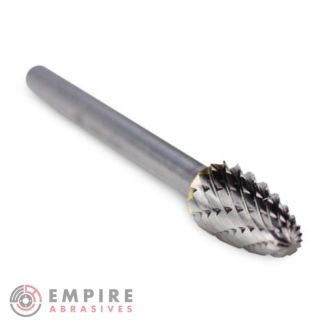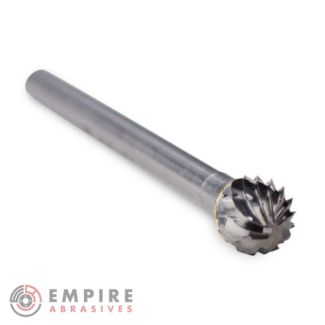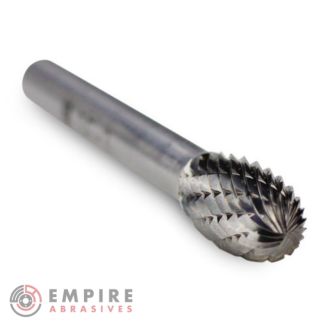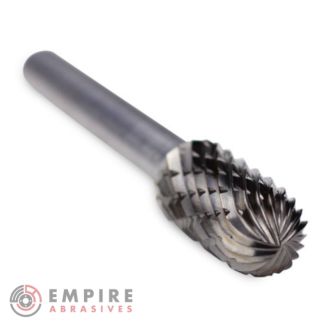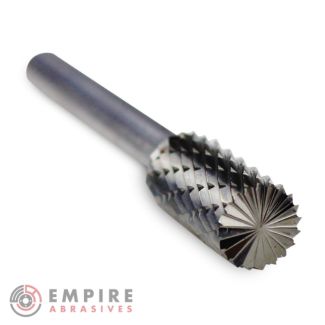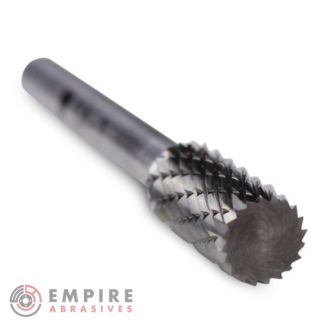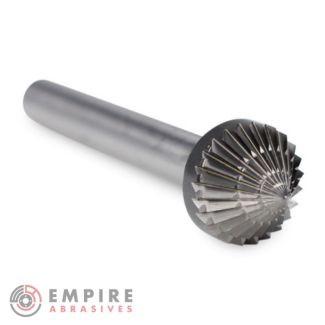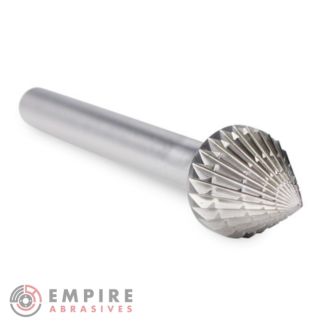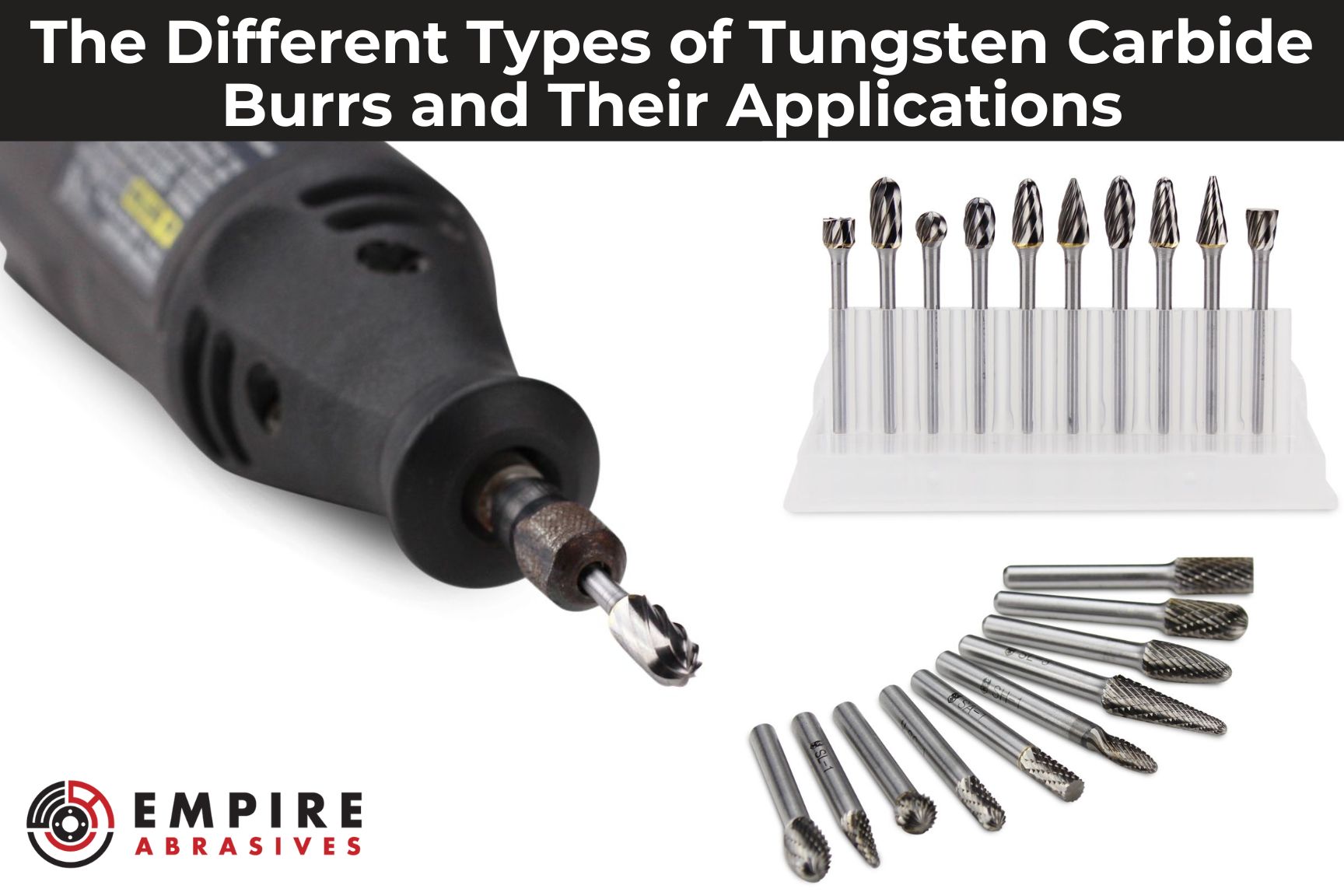
Carbide burrs are special tools for shaping, cutting, and grinding hard materials. Some people may refer to them as "rotary burrs," "die grinder bits," or "rotary files."
They are spinning tools that help you cut, grind, and remove sharp edges from work materials like metal to get the shape and smoothness you want.
If you're in the automotive, metal sculpting, dental, aerospace, sculpting, or welding industry, you're probably already familiar with carbide burrs. These cutting tools have become one of the most valuable tools in many industries.
And tungsten carbide burrs, more specifically, incorporate high-quality tungsten carbide for the head and stainless steel for the tool's shank.
But there are different carbide burrs applications, depending on the specific type of carbide burr you're working with, including but not limited to Aluma cut, double cut, ¼", ⅛”, and varying shapes. As you might assume, different types will have other applications.
Aluma Cut VS Double Cut Carbide Burrs
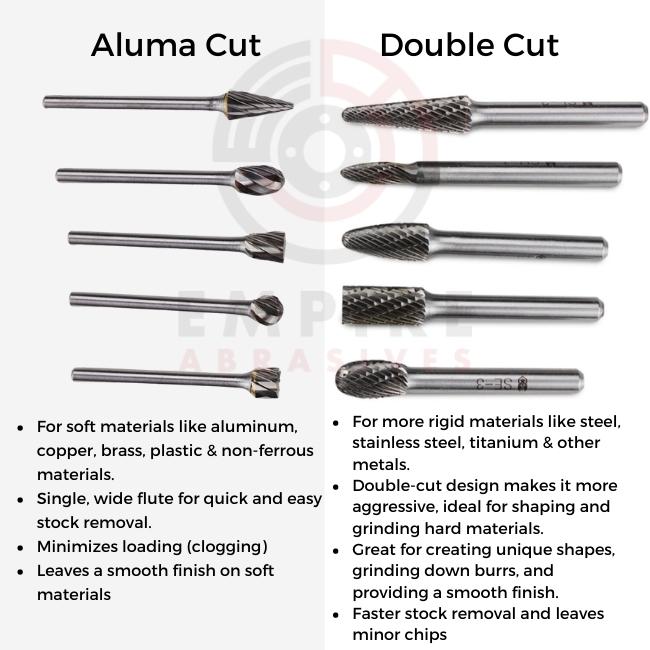
Aluma cut carbide burrs are designed for cutting soft materials, such as:
- Aluminum
- Copper
- Brass
- Carbon fiber
- Plastic
- Magnesium
- Rubber
- Zinc
- Other non-ferrous materials
Aluma cut also means the flutes are designed with a single, wide flute, which ensures quick and easy stock removal and minimal loading.
Aluma cut is usually used in automotive settings to smooth out sharper edges and remove burrs, as well as cutting various other materials.
On the other hand, double-cut carbide burrs are much more aggressive and better suited for cutting more rigid materials. Double-cut carbide burrs can be used to create unique shapes, grind down burrs, and create a smooth finish on hard materials, such as:
- Steel
- Stainless Steel
- Titanium
- Iron Alloys
- Nickel
- Inconel
- Cast Iron
- Chrome
- Brass
- Bronze
- Fiberglass
- Hard Rubber
- Hard Plastics
- Wood
People may prefer double-cut options for faster stock removal and more minor chips as well.
Factors To Consider When Choosing a Tungsten Carbide Burr
When selecting the right Tungsten carbide burr for your needs, it's important to consider three factors: the type of material, the size and shape of the workplace, and the desired outcome. We'll look at all three below.
The Type of Material Being Worked On
As mentioned above, carbide burrs applications are determined by the type of material being worked on. If you're working with softer materials such as aluminum and plastic, then an Aluma cut burr is the best choice.
For harder materials like steel and other metals, a double-cut carbide burr is the best option because it is more aggressive and better suited for cutting harder materials.
The Size and Shape of the Workplace
It's also important to consider the size and shape of the workplace. Depending on the size of your workspace, you may need to opt for a bigger or smaller carbide burr.
For example, a smaller ⅛” carbide burr may be the best option for getting highly detailed work done or when you need to get into tight spaces with better maneuverability. On the other hand a ¼” shank carbide burr will remove material faster. You may also need to consider if a long shank carbide burr is required if you need extra reach from your tools.
The Desired Outcome
Finally, you need to consider what you want the burr to accomplish for you. Each type of burr has a different shaped head with different uses for each. Many of these burrs can be used for similar tasks, but each has their own specialty.
You'll need to select the right burr for the job for the specific shape you want to create. We'll get into the different types of carbide shapes next, so you'll better understand.
Comparison of Different Tungsten Carbide Burr Shapes
Now that you understand what Tungsten carbide burrs are, it's time to look at the various shapes you might want to work with to create your desired outcome.
Inverted Cone
The inverted cone has a wide, flat end and points downwards into the shank.
This inverted cone shape is perfect for creating holes or grooves in materials, as it has a flat head and miniature size, allowing it to get into tight spaces.
More specifically, an inverted cone burr works well when you want to do edge machining in hard-to-reach areas. They're also suitable for producing undercuts and completing precision work.
With an inverted cone-shaped burr, you can:
- Perform edge machining from the rear
- Deburr a hole
- Enlarge a hole or groove
- Create new holes in a workpiece
- Deburr or countersink the interior of a hole
Cone
A cone-shaped burr is the opposite of the inverted cone in that the flat end is connected to the shank, and the tool is pointed at the end.
Cone-shaped tungsten carbide burrs create countersinks and counterbores, perfect narrow contours, and surface machining.
You can also use cone-shaped burrs for the following applications:
- Deburring edges of holes or slots
- Creating or enlarging notches
- Countersinking or counterboring screw holes
- Creating an edge bevel
And with the double-cut version, as with all double-cut versions of these carbide burrs, you'll get improved operator control.
Taper Radius Cut
Taper radius cut tungsten carbide burrs create smooth transitions between two curvatures. Like most carbide burrs, you can use this on a die grinder, rotary grinder, pencil grinder, and Dremel rotary tools.
You can use a tapered radius cut burr to create:
- Narrow contours
- Surface machining
- Smooth transitions between two curvatures
- Radius corners on edges or welds
- Conical holes
- Countersinks and counterbores
- Taper balls
Flame
Flame-shaped tungsten carbide burrs have angled, swirling grooves that make the burr resemble a flame.
They're ideal for creating detailed carvings. They can also create grooves, enlarge holes, and remove surface defects.
The flame-shaped carbide burr is also suitable for:
- Countersinking recesses
- Creating relief carvings
- Engraving wood, stone, bone, and eggshells
- Removing the excess material from workpieces
- Creating curves and angles in workpieces
Pointed Tree
Pointed tree burrs are similar to flame burrs but with a more pointed head and sharper grooves.
They can be used to make concave cuts and sharp angles. More specifically, the pointed ends help grind areas that may be difficult to reach otherwise.
These burrs are suitable for:
- Deburring curved edges or corners
- Grinding hard-to-reach places
- Creating concave cuts
Rounded Tree
A rounded tree, which looks like a pointed cone, helps smooth various materials, including wood, plastics, and metals. It's also used for shaving off materials for a smoother look.
This shape is similar to the ball-shaped burrs in the result, but the tree shape allows it to reach more complex areas.
Ball
A ball-shaped tungsten carbide burr is excellent for grinding, countering, hole-deburring, carving, shaping, hole milling, and micro-setting without any vibration.
If you need to engrave wood, stone, bone, eggshell, or plastics, you can use a ball tungsten carbide burr to get the job done.
Additionally, you can use ball-shaped burrs for:
- Preparing weld seams
- Modifying workpiece geometry
- Chamfering edges
- Cast material cleaning
- Build-up welding preparation
You can also find relatively small tungsten carbide ball burs, like this 1/4" shank diameter ball burr, which is ideal for intricate carving.
Oval/Egg
The Oval looks similar to the rounded tree but is slightly wider on the ends.
Oval/egg-shaped tungsten carbide burrs carve and define various materials, including wood, plastics, and metals. More specifically, the oval shape is perfect for enlarging holes, deburring edges of holes or slots, and creating notches.
You can also use an oval-shaped burr to:
- Reshape holes or slots
- Create bevels and chamfers
- Deburring
- Making concave cuts
- Creating details on wood, stone, and other materials
The oval shape helps make rounded edges and sometimes can help create some texture in the final result, as opposed to smoothing, bu8t you can also use it for smoothing.
Cylinder Radius Cut
The cylinder radius cut tungsten carbide burr is suitable for creating smooth transitions between two curvatures.
It can also generate radius corners on edges or welds, countersink or counterbore screw holes, and edge bevels.
This type of burr is perfect for detailed work, as the radius cut allows you to reach into tight spaces with great precision and is perfect for top and side cutting.
Cylinder End Cut
The cylinder end cut is similar to the radius cut but has a slightly more blunt head. This type of burr is perfect for creating grooves, enlarging holes, and deburring edges of holes or slots.
It can also remove surface defects, carve and define various materials, create curves and angles in workpieces, and deburr.
The cylinder end cut is a highly versatile burr and can be used for multiple applications.
Cylinder
A standard cylinder shape burr is excellent for removing broken screws and creating or enlarging notches. It can also be used to enlarge holes, create chamfers and bevels, and deburr various materials.
The cylinder shape is fantastic for reaching tight spaces and getting a clean, precise finish. It's also perfect for creating intricate details in wood, stone, and other materials.
90 Degree Cone
The 90-degree cone burr is perfect for countersinking.
It can also create radius corners on edges or welds, countersink or counterbore screw holes, and edge bevels.
This burr is particularly good for detailed work, as the cone shape allows you to reach into tight spaces with great precision. It also creates conical holes, countersinks, and other precise angles.
60 Degree Cone
The 60-degree cone is similar to the 90-degree cone carbide burr but with a slightly sharper angle, and it's also appropriate for countersinking.
Uses of carbide burr include removing broken screws and creating or enlarging notches. It can also be used to enlarge holes, create chamfers and bevels, and deburr various materials.
The 60-degree cone shape is ideal for reaching tight spaces and getting a clean, precise finish. It's also perfect for creating intricate details in wood, stone, and other materials.
Wrapping it Up
As you can see, there are many options to choose from when you go looking for a carbide burr. They are versatile tools, with a wide range of shapes and sizes, each tailored for various applications across different industries.
While most of these burrs can be used interchangeably for most tasks, like grinding edges and deburring holes, choosing the right burr can dramatically increase your efficiency and the quality of your work. At Empire Abrasives, we offer a full selection of high-quality tungsten carbide burrs you can choose from for your specific task. In addition to selling individual burrs, you can also try out a 5 or 10 piece carbide burr set to have the options on hand for all of your projects.
Still not sure which tungsten carbide burr is the best fit for your needs? Our expert team is happy to answer any of your questions and help you make the right choice. During regular office hours free to call us at 1-800-816-3824 or chat with us on our website, or you can email us at any time and we’ll get back to you right away!

